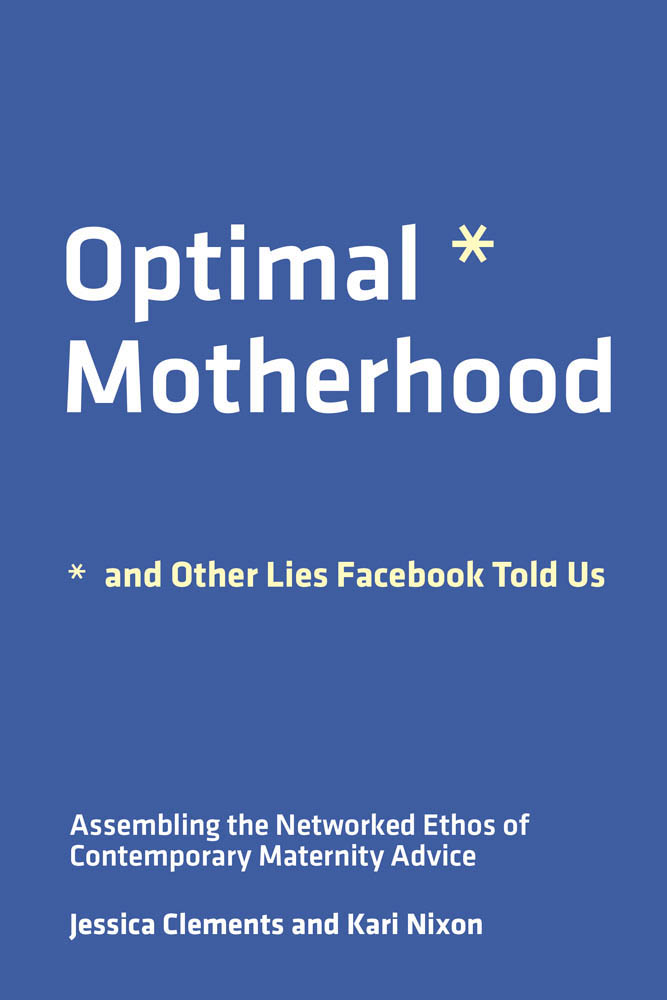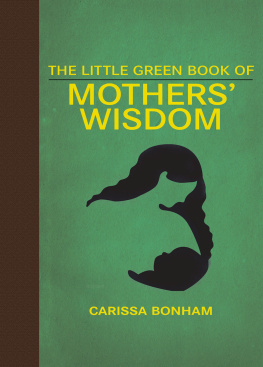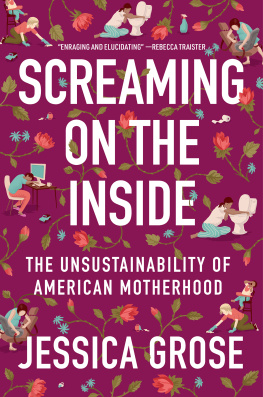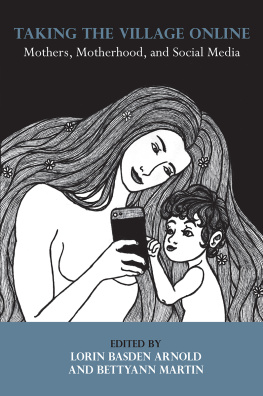Contents
Guide
Pagebreaks of the print version

OPTIMAL MOTHERHOOD AND OTHER LIES FACEBOOK TOLD US
Assembling the NetworkedEthosof Contemporary Maternity Advice
JESSICA CLEMENTS AND KARI NIXON
The MIT Press
Cambridge, Massachusetts
London, England
2022 Massachusetts Institute of Technology
This work is subject to a Creative Commons CC-BY-NC-ND license.
Subject to such license, all rights are reserved.

The MIT Press would like to thank the anonymous peer reviewers who provided comments on drafts of this book. The generous work of academic experts is essential for establishing the authority and quality of our publications. We acknowledge with gratitude the contributions of these otherwise uncredited readers.
Library of Congress Cataloging-in-Publication Data
Names: Clements, Jessica, author. | Nixon, Kari, author.
Title: Optimal motherhood and other lies Facebook told us : assembling the networked ethos of contemporary maternity advice / Jessica Clements and Kari Nixon.
Description: Cambridge, Massachusetts : The MIT Press, [2022] | Includes bibliographical references and index.
Identifiers: LCCN 2021057604 | ISBN 9780262543620 (paperback)
Subjects: LCSH: MotherhoodSocial aspects. | MothersPsychology. | Social media and society.
Classification: LCC HQ759 .C618 2022 | DDC 306.874/3dc23/eng/20220207
LC record available at https://lccn.loc.gov/2021057604
d_r0
Contents
List of Figures
Womens freedoms versus the Cult of True Womanhood.
Eight glasses of water vs. eight glasses of wine.
Home of Hope campaign to create awareness about Fetal Alcohol Spectrum Disorder.
Centers for Disease Control and Preventions Drinking Too Much Can Have Many Risks for Women infographic.
An infographic header for Centers for Disease Control and Preventions Drinking Too Much Can Have Many Risks for Women.
The top half of the Drinking Too Much Can Have Many Risks for Women.
The lower half of the Drinking Too Much infographic
Chris Gigantis parody infographic.
Andrew Easts Instagram post from November 14, 2019, teasing wife Shawn Johnson about her diminished alcohol tolerance post baby delivery
Birth plan.
Birth plan: box 5, page 2.
Birth plan: box 4, page 1.
Birth plan: boxes 3 and 4, page 3.
Birth plan: pages 4 and 5.
A viral Facebook post from June 2019, circulated by @taylorkulik.
Screenshot from Similacs The Mother Hood commercial.
Safe handling instructions found on infant formula.
Screenshot illustrating Ad Managers Detailed Targeting, from personal Facebook account.
Screenshot of sponsored advertisement for Huggies, from personal Facebook account.
Screenshot of Why Youre Seeing This Ad explanation for Huggies advertisement, from personal Facebook account.
Image of crying baby from Facebook post.
CDC Chart: SIDS, suffocation, and strangulation deaths per 100,000 live births.
NICHs Interactive Safe Sleep Room welcome message.
NICHs Interactive Safe Sleep Room dos and do nots message.
NICHs Interactive Safe Sleep Room couches and armchairs warning message.
Help promote safe infant sleep, Cook Childrens website leading image.
Examples of pregnancy test tweaking in Pregnancy Test Checker app: Original, grayscale, contrast adjustment, and color inversion.
Screenshot from social media pregnancy test tweaking group, illustrating complex group terminology.
Example of personal fertility cycle chart often used a supplementary point of visual data in social media pregnancy test tweaking groups.
Pregnancy Pro, Bluetooth-enabled pregnancy test product photo and description.
Screenshots from Pregnancy Pro app, while-you-wait-for-results options.
Pregnancy care center Facebook page post.
Series of tweets illustrating consequences for moms choosing childcare over careers during COVID.
White privilege infographic.
Bradshaw tweets support for Teigens courage in sharing her miscarriage story on social media.
A Facebook meme championing collective care.
A Facebook meme suggesting the collective value of personal forgiveness.
Acknowledgments
We would like to thank our undergraduate student researchers for their valuable contributions to this book: Madison Binyon, Jamison Dover, Nina MacDonald, and Meredith VandeBunte. From data logging to social media ad analysis to health practitioner and mom interviews, this book would not be as rich without their work. Their participation was made possible through the Hugh Johnston Interdisciplinary Research Endowment Grant, awarded by Whitworth University in the summer of 2019.
INTRODUCTION
I think it began with food pouches. You know the oneshalf-pint-sized vessels built from layers of laminated film. They contain mashed-up vegetables, laced with fruits to make kids eat it, and they have a convenient suck-spout to get it right down their gullets with minimal fuss or mess. Voila! Kid has their dose of veggies, and no one (mom or baby) has a meltdown.
I was standing in the aisle of the grocery store, holding two pouches in my hands, considering. On the one hand, the thought of getting something into this pipsqueak other than chicken nuggets felt like such an exhilarating win I could almost taste the success (apple-kale-mush-flavored success). On the other hand, shouldnt I be teaching her to eat food that looked like, well, food? Were there drawbacks to her not chewing or tactilely experiencing her food? What if she started demanding nothing but pouches (they seemed wildly popular with kids these days), and then she never learned to use a fork? What if I had a fork-challenged child going off to college one day? On the third hand (at this point in my life I had come to routinely wish I had three hands), she was presently screaming bloody murder at me for standingthe cart required constant movement to placate her, you see. There was no more time to think. I threw both pouches in the cart, grabbing a plastic spoon as an afterthought. Itll be OK as long as I make her eat it with a spoon, right?
Who knows, really. It could have been any of a million such moments that define modern motherhood, but I think that was the day I phoned my friend Jess, and we decided to write this book.
One thing has stuck with both of us since we became mothers: when you become a mother you enter a new world. That world involves a lot of baby care, of course, but here we also mean that the new mother enters a world in which she shares a subtle, vibrating electricity with every other mom she seesthe shared grasp of the tingling, raw, so-earnest-it-makes-your-eyes-sting, obsessive love for this tiny creature for whom you are suddenly responsible. The suffocating grip of that love is arrestingand suddenly, when you walk past a mother ruefully considering two slightly different flavors of pouched mush in the grocery store, what might have once seemed a laughably absurd first-world problem is suddenly a codex to your own world. You know pretty much everything shes standing there thinking. And because you know it, you know you are seen as well. Even if it goes unspoken, your struggles are seen and given space by some other mother who has been there. The planking eighteen-month-old refusing to get into the car seat is softened, here and there, by a knowing smile of a mother passing by with her four-year-old screaming something about Disney princesses. You dont have time to discuss it (because buckles are hard to navigate while under pressure, and Elsa










